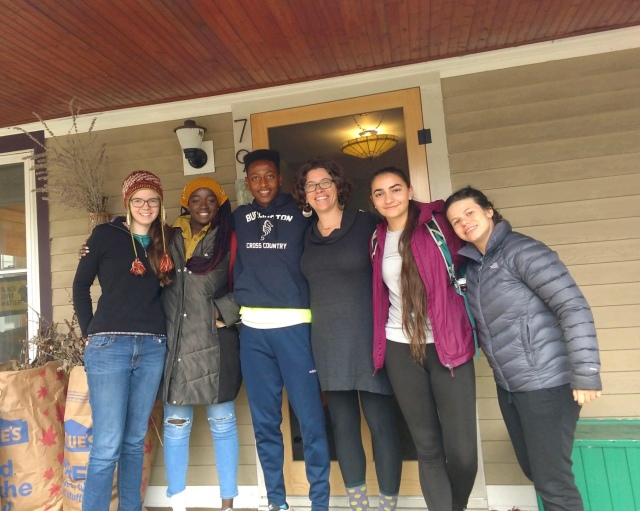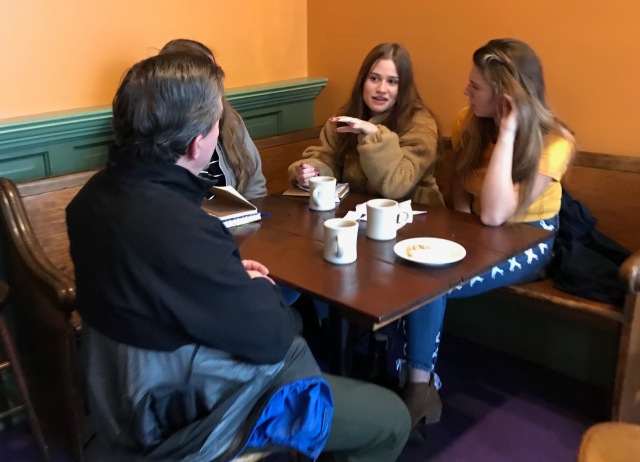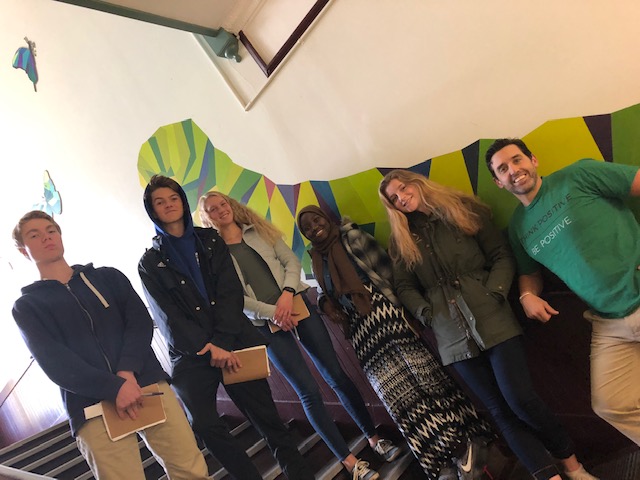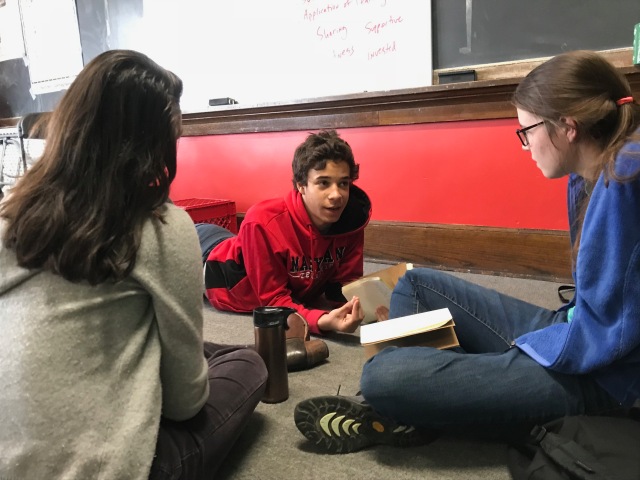Throughout the semester, our learning has been guided by a fundamental question: What does it mean to thrive?
This question framed our first unit, an exploration of the interdependent systems that make the city work. (Are our city systems helping Burlington thrive? What are the barriers to thriving?) The question was also the through-line for our exploration of the health of Lake Champlain. (Is the lake thriving? What are the connections between a thriving lake and a thriving city?) For the past few weeks, BCL students have been exploring what it takes for community itself to thrive.
We began by exploring several theoretical frameworks related to community-building, connection, and resilience. Next, we applied these frameworks to understanding our own BCL community, and then the city and its various neighborhoods. We began with a visit to City Hall, where we met with Gillian Nanton, from the Community Economic Development Office [CEDO]. Gillian’s experience with UNDP offered us a unique global perspective, and helped students connect the dots between issues in Burlington the U.N. Sustainable Development Goals that they had learned about during a recent conference at Shelburne Farms.

We then turned our gaze to the Old North End, a dynamic neighborhood that is the geographic midpoint between the High School and Burlington’s Downtown District. Students met with Laura Hale, a community organizer, and dug deep into questions of history, geography, equity and ethics.
After a morning with Laura, students’ typical “break” wasn’t really a break, since many of them flocked to her to continue the conversation.
Next, students broke into small groups and fanned out across the Old North End, to meet with a variety people who are connected to the neighborhood – as residents, business owners, service providers, etc. Over the course of two days, we held eight different community conversations.




BCL students also had the chance to host Michael Wood-Lewis, the founder of Front Porch Forum, and view the new documentary on FPF, Vermont’s Quiet Digital Revolution. Together, through questions and storytelling, we examined the challenges and opportunities of connecting in the digital age. We also questioned how our devices can lead to both interpersonal disconnection and connection.
Each of us had different takeaways from this series of community conversations, but there is one thing that everyone agrees on: The question of what it means – and what it takes – for a community to thrive is complicated. The good news is that students showed both a comfort and a willingness to wade into murky waters, where some of society’s most challenging dilemmas swirl. Here are just some of the questions that emerged:
- Where do vulnerability, belonging, and empathy fit into our understanding of thriving?
- What is our responsibility to one another?
- How can the City invest more in the health of neighborhoods and the city as a whole?
- How is community related to civic engagement?
- How does civic engagement relate to equity?

Far from shying away from these complex questions, students themselves seemed to thrive in the context of this inquiry. Outside of facilitated activities, side conversations seemed to pop up like mushrooms after a rainstorm. Small groups of students found themselves actively grappling with what it takes for a community to thrive.
This thinking also emerged in students’ writing. After a series of community interviews, Ruby reflected on what community means:
From all of the stories I have heard, from ISGOOD’s work to bring UVM and neighborhood’s together, to Bobby Riley’s work in the O.N.E., to my mother’s work in perinatal mental health at UVM, I have seen that change has happened. It is doable, hurts nobody, and strengthens communities and the relationships in the communities greatly. I have heard many different perspectives from different people, but I understand more clearly with each new person that it is up to you to make a difference; to better your community. If you see an opportunity…do something!
In BCL we have such a strong, tight-knit community. This was created by all the efforts from the teachers (and of course other contributors), and it makes me wonder how changes could be made to the community of BHS, to make it feel more connected and together. We need to think about how to build relationships with all students and teachers, so that people feel an actual sense of belonging. Because it is then that I think you really begin to love where you are. And Burlington, is a pretty great place.
Binti identified a consistent barrier to community:
One thing that makes it hard for a community to thrive is representation. Many of our community partners have talked about this being an issue and they are absolutely right. The representatives of communities being represented doesn’t properly reflect the demographics of the actual community. These are people who don’t identify or aren’t a part of the communities they represent. How are they suppose to speak on issues that don’t affect them and more importantly how do they know what is affecting their community if they’re not involved with them? This is a huge flaw in our system and until it’s corrected our communities will make no progress. As community organizer, Laura Hale, said, communities thrive when things are done with them not to them.
Isabel considered the interaction between group members and the group as a whole:
Community is really important because of the individual impacts it has and the way that it can help strengthen relationships. A thriving community can make life better for people because it is a place where there is a woven connection of people who advocate for and support each other. It can give people a purpose or meaning and (hopefully) is inclusive and with a diverse array of people.
Saja found a resonant example in her own life outside of school:
What community means to me is everyone being willing to understand each other and having responsibility. For example, in my work, we are a community. If something bad happens to one of us, we will all help that person. Like when I had a car accident I needed money to fix my car. My friend wanted to give me money, but I didn’t want it, since I didn’t know if I could give it back to her. So she suggested that she give me her shift, so I could make more money. I was able to cover my shift without asking for help. This is an example of a thriving community.
Wyatt reflected on the work of Theaster Gates, in Chicago:
Gates is a remarkable artists, but I’m still wondering the scale of the impact that Gates can have on his community. How do you take an idea that works in one neighborhood and expand to other parts of your city? How do you get other people to be inspired by this work to take up their own projects in their own communities? And how can we use our own resources to make our community thrive more?
Also, what specifically in Burlington can we do to make Burlington thrive more? We have so many resources here. How can we get engaged as a community to promote a thriving Burlington for the future of the city and its residents?

